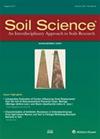Does soil thinning change soil erodibility? An exploration of long-term erosion feedback systems
4区 农林科学
Q2 Agricultural and Biological Sciences
引用次数: 1
Abstract
Abstract. Soil erosion rates on arable land frequently exceed the pace at which new soil is formed. This imbalance leads to soil thinning (i.e. truncation), whereby subsoil horizons and their underlying parent material become progressively closer to the land surface. As soil erosion is a selective process and subsurface horizons often have contrasting properties to the original topsoil, truncation-induced changes to soil properties might affect erosion rates and runoff formation through a soil erosion feedback system. However, the potential interactions between soil erosion and soil truncation are poorly understood due to a lack of empirical data and the neglection of long-term erodibility dynamics in erosion simulation models. Here, we present a novel model-based exploration of the soil erosion feedback system over a period of 500 years using measured soil properties from a diversified database of 265 agricultural soil profiles in the UK. For this, we adapted the Modified Morgan–Morgan–Finney model (MMMF) to perform a modelling experiment in which topography, climate, land cover, and crop management parameters were held constant throughout the simulation period. As selective soil erosion processes removed topsoil layers, the model gradually mixed subsurface soil horizons into a 0.2 m plough layer and updated soil properties using mass-balance mixing models. Further, we estimated the uncertainty in model simulations with a forward error assessment. We found that modelled erosion rates in 99 % of the soil profiles were sensitive to truncation-induced changes in soil properties. The soil losses in all except one of the truncation-sensitive profiles displayed a decelerating trend, which depicted an exponential decay in erosion rates over the simulation period. This was largely explained by decreasing silt contents in the soil surface due to selective removal of this more erodible particle size fraction and the presence of clayey or sandy substrata. Moreover, the soil profiles displayed an increased residual stone cover, which armoured the land surface and reduced soil detachment. Contrastingly, the soils with siltier subsurface horizons continuously replenished the plough layer with readily erodible material, which prevented the decline of soil loss rates over time. Although our results are limited by the edaphoclimatic conditions represented in our data, as by our modelling assumptions, we have demonstrated how modelled soil losses can be sensitive to erosion-induced changes in soil properties. These findings are likely to affect how we calculate soil lifespans and make long-term projections of land degradation.土壤变薄会改变土壤的可蚀性吗?长期侵蚀反馈系统的探索
摘要耕地的土壤侵蚀速度经常超过新土壤形成的速度。这种不平衡导致土壤变薄(即截断),从而使底土层及其下面的母质逐渐接近陆地表面。由于土壤侵蚀是一个选择性过程,地下层通常与原始表土具有截然不同的特性,截断引起的土壤特性变化可能通过土壤侵蚀反馈系统影响侵蚀速率和径流形成。然而,由于缺乏经验数据和在侵蚀模拟模型中忽略了长期可蚀性动力学,土壤侵蚀与土壤截断之间的潜在相互作用知之甚少。在这里,我们提出了一种新的基于模型的土壤侵蚀反馈系统的探索,在500年的时间里,使用从英国265个农业土壤剖面的多样化数据库中测量的土壤特性。为此,我们采用修正Morgan-Morgan-Finney模型(MMMF)进行建模实验,其中地形、气候、土地覆盖和作物管理参数在整个模拟期间保持不变。随着选择性土壤侵蚀过程去除表层土壤,该模型逐渐将地下土壤层混合成0.2 m耕层,并使用质量平衡混合模型更新土壤性质。此外,我们用前向误差评估来估计模型模拟中的不确定性。我们发现,99%的土壤剖面模拟侵蚀率对截断引起的土壤性质变化敏感。除截断敏感剖面外,其余剖面的土壤流失量均呈下降趋势,表明侵蚀率在模拟期间呈指数衰减。这在很大程度上可以解释为土壤表面泥沙含量的减少,这是由于选择性地去除了这种更容易被侵蚀的粒度部分以及粘土或砂质基质的存在。此外,土壤剖面显示出残留的石头覆盖物增加,覆盖了陆地表面,减少了土壤分离。相比之下,具有粉质地下层的土壤不断地向犁层补充易于侵蚀的物质,这阻止了土壤流失率随时间的下降。虽然我们的结果受到我们数据中所代表的气候条件的限制,正如我们的建模假设一样,我们已经证明了模拟的土壤损失如何对侵蚀引起的土壤性质变化敏感。这些发现可能会影响我们计算土壤寿命和对土地退化进行长期预测的方式。
本文章由计算机程序翻译,如有差异,请以英文原文为准。
求助全文
约1分钟内获得全文
求助全文
来源期刊

Soil Science
农林科学-土壤科学
CiteScore
2.70
自引率
0.00%
发文量
0
审稿时长
4.4 months
期刊介绍:
Cessation.Soil Science satisfies the professional needs of all scientists and laboratory personnel involved in soil and plant research by publishing primary research reports and critical reviews of basic and applied soil science, especially as it relates to soil and plant studies and general environmental soil science.
Each month, Soil Science presents authoritative research articles from an impressive array of discipline: soil chemistry and biochemistry, physics, fertility and nutrition, soil genesis and morphology, soil microbiology and mineralogy. Of immediate relevance to soil scientists-both industrial and academic-this unique publication also has long-range value for agronomists and environmental scientists.
 求助内容:
求助内容: 应助结果提醒方式:
应助结果提醒方式:


